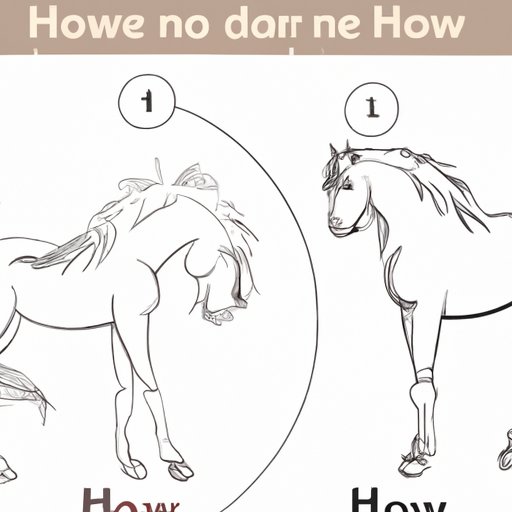Introduction
Drawing horses can be a challenging task for both beginners and seasoned artists. Horses are complex animals with intricate muscular structures and unique features, making them a compelling yet difficult subject to capture on paper. However, with the right techniques, materials, and patience, anyone can learn to draw a horse. In this article, we’ll walk you through a step-by-step guide on how to draw a horse, discuss the components of their anatomy, recommend the best materials to use, share the benefits of watching tutorial videos, offer inspiration from various artists, and provide tips for avoiding common mistakes. Let’s get started!
Step-by-Step Guide
To begin drawing your horse, start by sketching a basic outline of the animal’s body. A simple circle should be drawn for the head, a rough oblong shape for the body, and four long lines coming from the body for the legs. Then, focus on refining the shape of each segment while ensuring they are proportionally sized. Draw guidelines to help position key features, such as the eyes, nostrils, ears, mouth, and legs. Once you have a solid starting point, start adding details such as muscles, hooves, tail, and mane. Use shading and texture to add depth and dimension to your drawing. With practice, you’ll learn to add realistic, detailed features to make your horse look lifelike and vibrant.
Breaking It Down
When it comes to drawing horses, understanding the anatomy is essential to drawing a convincing horse. Different breeds of horses have different physical characteristics, but all share similar features such as long legs, a streamlined body, and a distinctive mane and tail. Pay attention to the horse’s bone structure, muscles, and proportions, such as their head-to-body ratio, leg length, and the relationships between different body parts. Once you gain an understanding of the different components, you can start incorporating them into your drawings, resulting in more accurate and detailed work.
Materials Needed
To start drawing horses, you’ll need pencils, paper, an eraser, a sharpener, and some shading tools such as graphite sticks and charcoal. Investing in quality materials is worthwhile, as it will help you create more professional-looking drawings. Popular brands include Staedtler, Prismacolor, and Faber-Castell. You may also want to consider investing in a graphics tablet that can be connected to a computer, which allows for greater precision and the ability to digitally manipulate the final artwork.
Videos
Videos can be an excellent resource for learning how to draw horses. Many artists have created detailed tutorials, breaking down the process step-by-step with live demonstrations. Watching videos can also help you understand the different approaches of other artists, which can inspire you to try new techniques and styles. Some of the most recommended tutorial videos can be found on YouTube and Skillshare, so be sure to check them out.
Inspiration
Looking to other artists can be an excellent method to gain inspiration and ideas for your own work. There are many artists out there who specialize in drawing horses, and by examining their work, you can learn to see how they approach horse anatomy, style, texture, and color. Consider experimenting with different styles of art and mediums to find your own unique approach.
Mistakes to Avoid
At the beginning stages of learning how to draw horses, it’s common to make mistakes. Some of the most common mistakes include misidentifying proportions, failing to shade sufficiently, and overlooking details such as muscle definition, hooves, and eyes. Avoid these mistakes by taking the time to study a horse’s anatomy, using proper shading and texture techniques, and paying close attention to visual details in reference images.
Practice and Patience
Like with any other skill, practice makes perfect when it comes to drawing horses. Don’t get discouraged by early struggles; draw and redraw as much as possible to enhance your skills. Take your time, and focus on improving each piece incrementally. Additionally, be patient with yourself – becoming a proficient artist takes time and plenty of practice. With a commitment to regular practice and patience, you will eventually develop the skills to create beautiful horse drawings.
Conclusion
By using the tips and techniques mentioned in this article, you can learn how to master the art of drawing horses. Start with a basic sketch and use guidelines to get proportions right. Study horses’ anatomy to accurately depict their features, invest in quality materials, and watch tutorial videos for tips and inspiration. Even if you’re new to drawing, with time, dedication, and a willingness to learn, you can create beautiful and realistic-looking horse artwork that you’ll be proud of.
